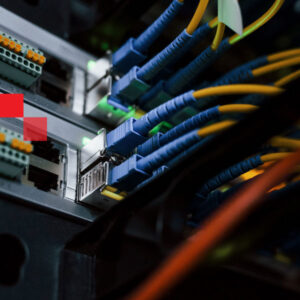Edge and micro data centers are multiplying fast—from telecom roadside shelters to enterprise mini-POPs. Yet every rack still depends on precise optical patching, often in remote, unattended locations. Manual work orders are too slow for the pace of distributed computing.
XENOptics’ robotic fiber switching platform extends carrier-grade automation to the edge, enabling lights-out maintenance with zero on-site staff.
The Edge Challenge: Small Sites, Big Risk
Micro data centers bring compute closer to users, but they multiply the physical layer ten- or hundred-fold. Each site may host just 4–10 racks, yet every fiber patch or re-route still needs skilled hands. That’s untenable when facilities are scattered across regions or deployed in harsh environments.
Unattended sites also face:
- Limited staffing: No resident technicians.
- Environmental stress: Temperature swings and vibration.
- Access control: Physical visits increase security exposure.
The result—higher OPEX and longer repair cycles for what should be low-touch infrastructure.
Robotic Switching at 1U Edge Scale
XENOptics compresses its 3D-Optical-Switch (3D-OS) technology into compact CSOS-72/144 units that mount in a single 19-inch rack space. Each unit performs fully automated, non-blocking optical cross-connects for 72 to 144 fibers, supporting simplex or duplex LC interfaces.
Key specifications for connectorized operation:
- Insertion loss: ≤ 1.0 dB
- Return loss: < -55 dB (UPC)
- Switching time: 36–60 seconds
- Power draw: ≈ 6 W idle, < 0.5 W sleep
The passive-latching design keeps all light paths active during power loss—critical for edge deployments running on DC or solar backup.
Zero-Touch Operations
Once installed, every reconfiguration, test, or failover can be executed remotely through the same management ecosystem used for core facilities:
- Web GUI and REST API: For single-unit control or SDN orchestration.
- SNMPv2/v3 integration: Works with existing DCIM/NMS tools.
- Element & Network Management Systems (EMS/NMS): Provide topology views, task queues, and audit logs.
A connection can be created, rerouted, or disconnected in under a minute—without human intervention. Provisioning that once took hours now completes in the time of a software command.
Lights-Out Maintenance Becomes Real
 Robotic patching isn’t just faster—it’s safer and greener.
Robotic patching isn’t just faster—it’s safer and greener.
- No manual patching errors: Automation eliminates mis-patches that cause up to 60 % of outages.
- Reduced truck rolls: Hundreds of on-site visits avoided annually translate to lower emissions and service costs.
- Continuous uptime: Passive latching and super-capacitor UPS ensure 100 % signal continuity during outages.
A single operator can now manage dozens of unmanned sites from a central NOC, with full audit trails and port-level status visibility.
Density and Scalability in Harsh Environments
Edge facilities demand both ruggedness and scale. The CSOS platform meets NEBS 3, ETSI 300019 Class 3.2, and IEC 60068-2-14 temperature-cycling standards, operating from −40 °C to +65 °C.
For larger micro-colos or regional aggregation sites, XSOS-288 and XSOS-576D variants scale the same architecture to 3,000–7,000 ports per rack. Each robotic cross-connect completes a patch in 24–60 seconds while maintaining < 1 dB insertion loss.
This modular range allows a unified management plane from a single 1U edge node to multi-rack urban hubs—all under one RESTful API.
Proven ROI for Distributed Networks
Analysis from the Automation · Intelligence · Sustainability (AIS) whitepaper shows automation savings of ≈ $425 k per MW annually, with typical payback under 12 months.
At the edge, where a 10-rack micro-DC might consume < 50 kW, savings scale proportionally through:
- 60 % fewer fiber-related outages
- 65 % reduction in field technician labor
- Energy draw < 1 % of an equivalent active ROADM system
Combined, these benefits make robotic patching the only viable path to lights-out fiber management across dispersed networks.
Ready for SDN and Edge AI
All XENOptics systems expose a REST API and SDN-ready schema, enabling orchestration by higher-layer controllers. Integrators can dynamically re-route optical paths in response to workload shifts, latency policy, or predictive-maintenance triggers.
For AI inference at the edge, where micro data centers handle federated or privacy-sensitive tasks, this flexibility allows traffic steering without dispatching staff—closing the gap between digital and physical layers.
The Future Is Unattended
Edge and remote server sites will continue to expand faster than staff can. By embedding robotic switching and passive-latching optics into each node, operators gain the same auditability, density, and reliability as their core data centers—without the overhead.
From a single 1U unit in a desert shelter to a high-density metro micro-DC, the principle is the same: keep the lights out, and the fibers connected.

